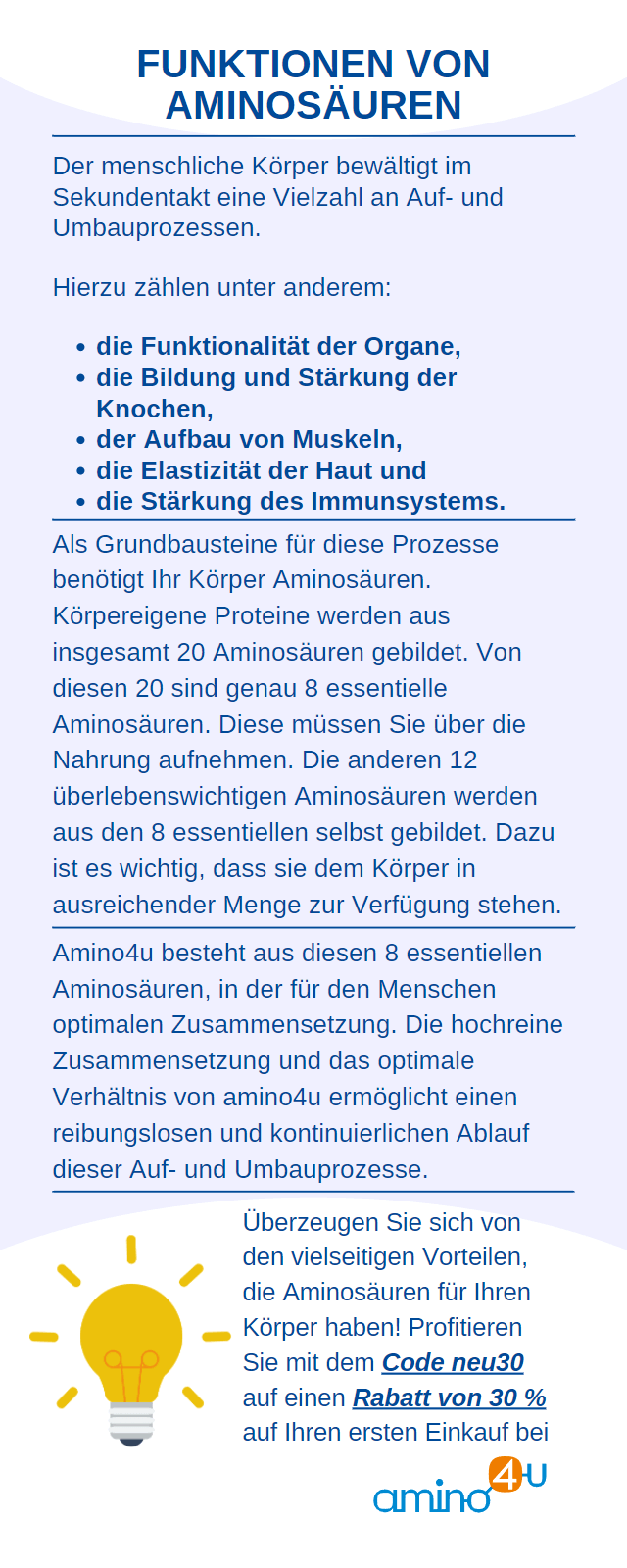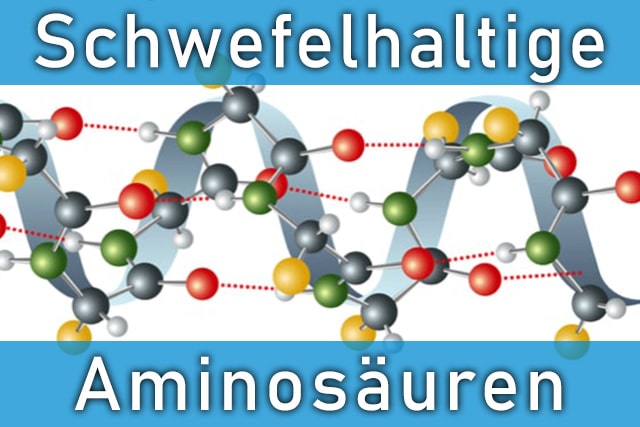Amino acids are essential for the human body and other living organisms as building blocks for proteins. Proteins serve as important substances for building cellular and extracellular structures.
Among the numerous amino acids, there are 20
proteinogenic amino acids that have a protein-forming effect in humans. The human organism cannot produce eight of these protein building blocks itself, so they must be consumed regularly with food. They are therefore also referred to as indispensable or
essential amino acids .
Why proteins are so important for the body
Macromolecular substances occur in the cells of all living things, which, due to their properties and chemical structure, are similar to the protein in bird eggs. That is why they are called proteins.
The foreign word “
protein ” is derived from the Greek word “
proteios ” meaning “
the first ” or “
the most important ”. This already gives us an indication of the
importance of proteins for living organisms.
Similar to carbohydrates, proteins carry out a large number of important tasks within the body. However, proteins have a macromolecular structure and their building blocks are amino acids.
The
most important tasks of proteins are:
- enzymatic catalysis
- Transport and storage
- the coordinated movement
- mechanical support functions
- strengthening the immune system
- the triggering and transmission of nerve impulses
- Growth control and cell differentiation

-
Enzymatic catalysis
Almost all chemical reactions in the body are carried out by certain macromolecules that we call enzymes and consist predominantly of proteins. This is why it is also referred to as enzymatic catalysis.
Some of these processes are simple, while others - such as the replication of a DNA strand - are very complicated. In living organisms there are very few chemical processes that take place without enzymes. They therefore have a special meaning.
-
Transport and storage
A special group of proteins is responsible for the transport of small molecules and ions. For example, the well-known hemoglobin serves as an oxygen carrier in red blood cells (erythrocytes). The related protein myoglobin takes on this task in the muscles.
Iron, in turn, is moved in the blood plasma by transferrin and stored in a complex in the liver together with ferritin.
-
Coordinated movement
Proteins form the essential component of muscle tissue. Its contractions are carried out by two different types of filaments, which also consist of proteins. Even microscopic movements such as the movement of sperm cells or the migration of chromosomes during cell nucleus division (mitosis) are based on proteins.

-
Mechanical support functions
Human bones and skin have high tensile strength. This is guaranteed by the well-known collagen, which is also a (fiber) protein.
-
Strengthening the immune system
Antibodies are a highly specific group of proteins in the organism.
They are able to recognize, bind and render harmless viruses, bacteria and foreign cells of other organisms.
-
Triggering and transmission of nerve impulses
When certain stimuli - cold, heat, pain and others - are brought to the nerve cells, they respond with the help of so-called receptor proteins.
An example is rhodopsin in the rods of the retina in the eye, which serves as a photoreceptor. Other receptor proteins can be stimulated by molecules such as acetylcholine. They regulate the transmission of nerve impulses at the connections (synapses) between nerve cells.
-
Growth control and cell differentiation
We also need proteins in our body for the differentiation of the different body cells and their proper growth based on the existing genetic information. We therefore refer to them as “ growth factor proteins ”.
The formation of neuronal networks, for example, is controlled by a “ nerve growth factor ”. Other cellular activities are coordinated by hormones. The majority of all of these substances are proteins, including insulin.
In general, we understand proteins in cells as sensors that control the flow of energy and matter.

Complex interaction of proteins
The protein to-do list is not complete. This is due, among other things, to the fact that the interaction between the individual proteins is very complex. So far, science has only been able to describe it in vague terms.
Technical language refers
to the entirety of all proteins and their interaction in the organism as the “
proteome ”. Comparable to the term “
genome ” for all genes in the body.
Since the vital proteins are generated from at least one amino acid, we can draw appropriate conclusions about the supply of the small protein building blocks.
Briefly summarized, it can be said:
Without amino acids proteins there is no proper management and control of the vital body or metabolic functions.
Why an adequate supply of amino acids is important
Before we go into the tasks mentioned in detail, a few comments on the interaction between
amino acids and proteins .
Since proteins are vital and are formed from amino acids, it is obvious how important the latter are.
As soon as even one
amino acid is missing in the body , all proteins are impaired in their functions. Therefore, a permanent deficiency can have harmful consequences for health.
The most common consequences of an
amino acid deficiency include an increased susceptibility to:
- infections,
- joint problems,
- Deficits in building muscles as well
- a general decline in performance and concentration.
Some
diseases of civilization such as diabetes or obesity can also be traced back to a metabolic disorder and thus to a deficiency in the supply of
amino acids .
To determine this, doctors can carry out an analysis of your amino acid content to determine the given concentration in your organism.
Conversely, it should be noted that - similar to vitamins - an oversupply of the small protein building blocks could be harmful to your health.

Anyone who takes an
amino acid supplement should therefore always ensure that the dosage is correct. Too high a concentration over long periods of time can, for example, have a negative effect on the kidneys or liver.
Aromatic amino acids
We describe
amino acids as aromatic if they have a corresponding side chain in their chemical structure. Here we discuss their properties and occurrence.
There are four aromatic amino acids:
- phenylalanine,
- tyrosine,
- tryptophan and
- Histidine (some of which is also assigned to the protein building blocks with a basic side chain).
The
first three aromatic representatives in this list have a benzene ring in the side chain in their chemical structure. An exception is histidine, which has an
imidazole ring .
-
Phenylalanine
Phenylalanine is an essential amino acid and a precursor to tyrosine, from which hormones and other important substances such as adrenaline are formed. Infants in particular need a high daily intake in the first months of life.
With increasing age the need becomes significantly less.
The aromatic phenylalanine is particularly found
in the following foods :
- dried soybeans
- dried peas
- pumpkin seeds
- walnuts
- poultry
- pork meat
- Salmon
-
Tyrosine
Since tyrosine is formed from phenylalanine, this
amino acid is also considered aromatic, but is one of the non-essential protein building blocks. However, it becomes essential as soon as there is a deficiency of phenylalanine.
This is the case with the disease phenylketonuria. It is a metabolic disease due to an
enzyme deficiency in which phenylalanine cannot be broken down. This causes it to build up in the body.
This is why, on the one hand, neurological sequelae occur. On the other hand, the organism cannot produce tyrosine or the substances synthesized from it. As a consequence, it is necessary to avoid foods containing phenylalanine while consuming tyrosine at the same time.
Tyrosine is responsible for the
production of adrenaline and norepinephrine , which increase heart rate and blood pressure. This aromatic amino acid is also the starting material for certain thyroid hormones, which influence metabolism and basal metabolic rate.
The neurotransmitters dopamine and L-dopa are also produced from tyrosine. You are responsible for
- Signal transmissions in the brain,
- for memory and concentration as well
- the motion control.
If the body does not have enough tyrosine available, it not only leads to a reduction in the substances mentioned. The substance melanin, which is required for the pigmentation of skin, eyes and hair, can then no longer be produced sufficiently.
In addition, tyrosine, as an
aromatic protein building block, is a structural component of insulin receptors and is therefore crucial for insulin signaling.

-
Tryptophan
The aromatic tryptophan is an
essential amino acid and a precursor of niacin, which is of great importance for energy metabolism. Tryptophan is also considered a
basic product for the hormones melatonin and serotonin. The latter is also known as the happiness hormone.
A lack of it can lead to depression and a reduced sense of pain. Conversely, an excessive amount triggers inner restlessness, anxiety and depression.
Serotonin also promotes blood clotting and has a slight appetite-suppressing effect. Together with melatonin, it regulates human sleep-wake states.
Melatonin, in turn, is generated directly from serotonin. The hormone helps you fall asleep and is
responsible for restful sleep . It reaches its peak level in the bloodstream during the deep sleep phase. Accordingly
, amino acids could have a positive effect on sleep disorders .
Tryptophan, which is important for all of the substances mentioned, can be found primarily
in the following food sources :
- soybeans
- dried peas
- cashew nuts
- cocoa
- pork meat
- poultry
- Salmon
Similar to phenylalanine, infants in particular are dependent on a high daily intake compared to adults.
-
histidine
Histidine is one of the essential
amino acids and, like phenylalanine and tryptophan, is also required to a greater extent by infants and young children.
You can find the
protein building block, for example, in:
- dried soybeans
- dried peas
- wheat germ
- beef
- tuna
- Salmon
Histidine is fundamental for the formation of histamine, a hormone-like substance that is responsible for numerous functions in the human body. These include, for example, the muscle contractions of the bronchi and uterus.
Histamine has a
dilating effect on the blood vessels , promotes the release of gastric juice and stimulates intestinal peristalsis. Increased histamine production occurs in allergic reactions, strong sunlight or burns.
In such cases, the substance causes increased blood circulation, which visually manifests itself as reddening of the skin.



 Anyone who takes an amino acid supplement should therefore always ensure that the dosage is correct. Too high a concentration over long periods of time can, for example, have a negative effect on the kidneys or liver.
Anyone who takes an amino acid supplement should therefore always ensure that the dosage is correct. Too high a concentration over long periods of time can, for example, have a negative effect on the kidneys or liver.




